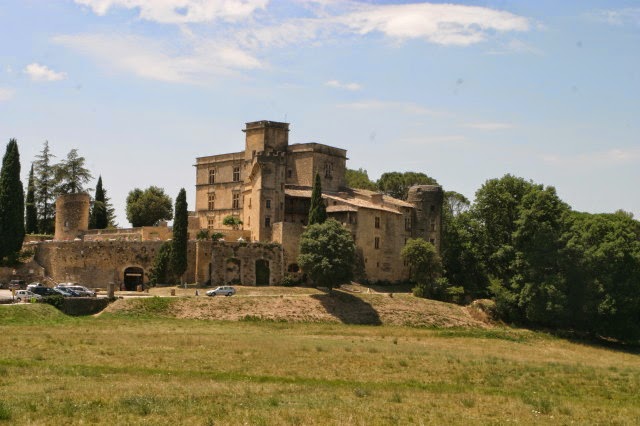The Château of Lourmarin is only a short distance away from the village of Lourmarin.
Originally built in the 12th century as a fortress, it was transformed in the 15th century by the chamberlain of King René I of Anjou. By adding an annex in 1526, the new owners made it the first Renaissance building in the Provence. After the French Revolution the Château descended into ruins till 1921 when it was bought by Robert Laurent Vibert, a producer of cosmetics. With the help of Henri Pacon, an architect, he restored the castle. Unfortunately he died in a car accident in 1925. He left the Château to the Académie of Sciences, Agriculture, Arts and Belles Lettres in Aix en Provence with the proviso that it would be transformed into a trust to support young artists.
The Foundation developed the library, it now holds 28.000 books and documents. During the year concerts and conferences are organised and each summer it welcomes young artists (painters, sculptors, musicians, authors and researchers. They stay at the Château and receive a grant to be able to concentrate on their work.
As you enter the Château a colourful display of roses around a bassin with waterlillies and a sculpture (Reflexsun) by Christophe Bricard attracts your attention.
Lovely views from the courtyard:

Several Anduze pots filled with Geraniums are dotted along the court yard.
On our way to the entrance to the tower, we passed a bed of magnificent Dahlias. Behind the Dahlias, Ipomoea indica (blue flowering Morning Glory).
The first room to visit is the Dining Room with 3 original beams near the old fireplace.
All along the walls are engravings of Rome by Giovanni Battista Piranese (1770-1778). Goethe, having seen the engravings by Piranese, was disappointed when he visited Rome, it was nothing like the engravings. An Aubusson tapestry (only 2 vegetable dyes were used, blue-green and brown) adorns the walls. A showcase with Murano glassware and a large Delft Blue vase.
The kitchen with furniture of N.E. France. Gleaming copper ware, an old Biot olive oil jar in the corner of the fireplace.
An incredible spiral staircase leads to the floors above, next the Ladies Bedroom
Further up the staircase we pass another bedroom similar in style to the ladies bedroom, and right on top is the music room with several pianos, harpsichord, drums and oriental instruments hanging on the walls.
After our visit we had some time to visit Lourmarin. Lots of tempting shops. Most of us had lunch at Restaurant 'La Recreation', before setting off to Val Joanis.
After lunch we made our way to Château Val Joanis, 1.5 km outside Pertuis. It is a 400 ha. estate of which 100 ha is planted with vines. It was once owned by Jean de Joanis, secretary to King Louis III of Naples.
After being neglected for many years Val Joanis was bought in 1977 by the Chancel family. Cécile Chancel with the help of architect, Tobbie Loup de Viane, decided in 1978 to create a potager that resembled château potagers of the 18th century. Ornamental but at the same time producing all the family's vegetables, fruits and flowers.
They started the project in 1980, it was finished in 1990. In 2005 the potager received the honour of being chosen as a 'Jardin Remarquable' and in 2008 it became 'Jardin de l'année 2008. In 2011 the château was sold to a German/Dutch couple, the family Rosen.
The garden is divided up into 3 terraces:
The potager.
Roses and other trained fruit.
Ornamental trees and shrubs.
Punica granatum 'Flore Pleno' a flowering pomegranate
The potager is divided into beds, between the beds are paths. The soil in the potager is covered with ground cocoa shells. The advantages are:
- It suppresses weeds and retains moisture. Once it has been watered or rained upon, it forms a crust binding the cocoa shells.
- The rich colour contrasts well with the green foliage of the plants.
- It repels slugs and snails.
Every bed in the potager is surrounded by either a small hedge or panels of iron rods (3m long x 30 cm high ) on poles stuck into the ground.
They used quite a variety of plants as hedges, all clipped to the desired height:
Buxes sempervirens (Common Box).
Buxes sempervirens 'Elegantissima' (with a narrow white margin).
Elaeagnus x ebbingei.
Phillyrea angustifolia.
Pistachia lentiscus.
Quercus ilex (our common evergreen oak).
To give form to the potager tall clipped trees were used:
Corylus maxima 'purpurea' (purple leaved hazel).
Laurus nobilis (Bay-leaf) in the shape of obelisks.
Taxus baccata (Yew) idem dito.
Ostrya carpinifolia (Hop hornbeam) clipped into tall panels.
Parrotia persica (normally it grows up to 8 m, with a spread of 10 m).
Cupressus sempervirens 'Stricta', Italian cypres tree.
Espalier apple and pear trees at various heights.
Some grasses:
Miscanthus sinensis.
Imperata cylindrica 'Rubra'.
For decorative purposes and special colourful effects, they planted long rows of:
Bupleurum fruticosum
Caryopteris (green and silver leaved varieties)
Cornus alba 'Elegantissima'
Gaura lindheimeri (white variety)
Indigofera
Inula magnifica
Lagerstroemia
Lavandula angustifolia and intermedia (Lavander and Lavandin)
Perovskia 'Blue Spire'
Rudbeckia 'Herbstsonne'
Vernonia crinita
Vitex agnus-castus
In amongst the clipped hedges, central partitions, shrubs and perennials; herbs, vegetables and small fruit bushes (red currants, black currants etc.) were grown.
Most of the roses lining the rose tunnel are spring flowering varieties, now finished flowering.
At the moment the most striking colourful feature are the lavenders in bloom.
Photographs: Kelvin Crawford
























No comments:
Post a Comment